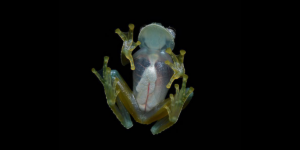
Stacey Finley is the Gordon S. Marshall Early Career Chair and a Gabilan Assistant Professor at USC Viterbi. Photo credit/Michelle Henry
Since high school, Stacey Finley knew she had a fierce one-two punch, academically speaking: she enjoyed math and excelled at it.
A dizzying combination in the fight against cancer.
Perhaps it was destiny then that this spring Finley, a Gabilan Assistant Professor at USC Viterbi, was awarded the inaugural Leah Edelstein-Keshet Prize from the Society of Mathematical Biology (SMB).
For the award, Finley was selected for critical research she began during her post-doctoral fellowship at Johns Hopkins University in Baltimore, Md.
The aim: to develop a mathematical model to understand the role of angiogenesis in cancer.
Angiogenesis is the formation of new blood vessels from a pre-existing network of blood vessels, typically a normal and healthy biological process. For instance, newly-formed blood vessels facilitate the repair of muscle tissue after exercise.
But Finley explained that angiogenesis is exploited in cancer because a new network of blood vessels can deliver nutrients to a tumor, helping it flourish. In effect, preventing angiogenesis could potentially stop tumor growth in its tracks.
To that end, Finley prepared a computational model of a human patient with breast cancer, focusing on a growth factor that mediates angiogenesis known as vascular endothelial growth factor or VEGF.
“We can predict how VEGF is distributed through the body, how it binds to its receptors in normal tissue and blood and also in tumor tissue,” Finley said. “We can also use the model as a tool to predict the effects of anti-angiogenic therapies.”
In her Computational Systems Biology Laboratory at USC Viterbi, Finley builds on her post-doctoral research by looking at more comprehensive networks of angiogenesis factors. In a new mathematic model of tumor tissue, she simulates drugs that mimic the action of thrombospondin-1 or TSP-1, a protein that inhibits angiogenesis.
“We can apply the model to better understand what the tumor profile is that will have the best response to these therapies,” Finley said. “We can see the effect of varying different properties of the tumor and how these changes influence the tumor’s response to these anti-angiogenic therapies.”
To develop extensive simulations of cancer development, Finley’s research group compares the model predictions against published clinical measurements. Her team is now beginning to test and validate the models using in-vitro experiments.
“I’m really excited about being able to better inform the development and also optimization of drugs in cancer, so what motivates me is developing a quantitative framework that we can really use to test out the effects of these drugs,” Finley said.
Going forward, Finley’s faith in numbers remains a major motivator. With her mathematical acumen, she will no doubt continue to contribute greatly to the rapidly developing field of computational models used in cancer research.
“Even as an undergraduate student, I enjoyed my math classes,” Finley said. “Especially seeing how you could use calculus and linear algebra, these advanced math topics in engineering applications.”
Leah Edelstein-Keshet became the first woman President of the Society for Mathematical Biology in 1995. The Leah Edelstein-Keshet Prize recognizes women who are making exceptional scientific contributions in mathematical biology, developing strong independent research programs, and exhibiting the potential for progressing at a high level of scientific endeavor and leadership. For more information on this award and others from the Society of Mathematical Biology, please visit smb.org.
Published on April 19th, 2017
Last updated on June 14th, 2018









